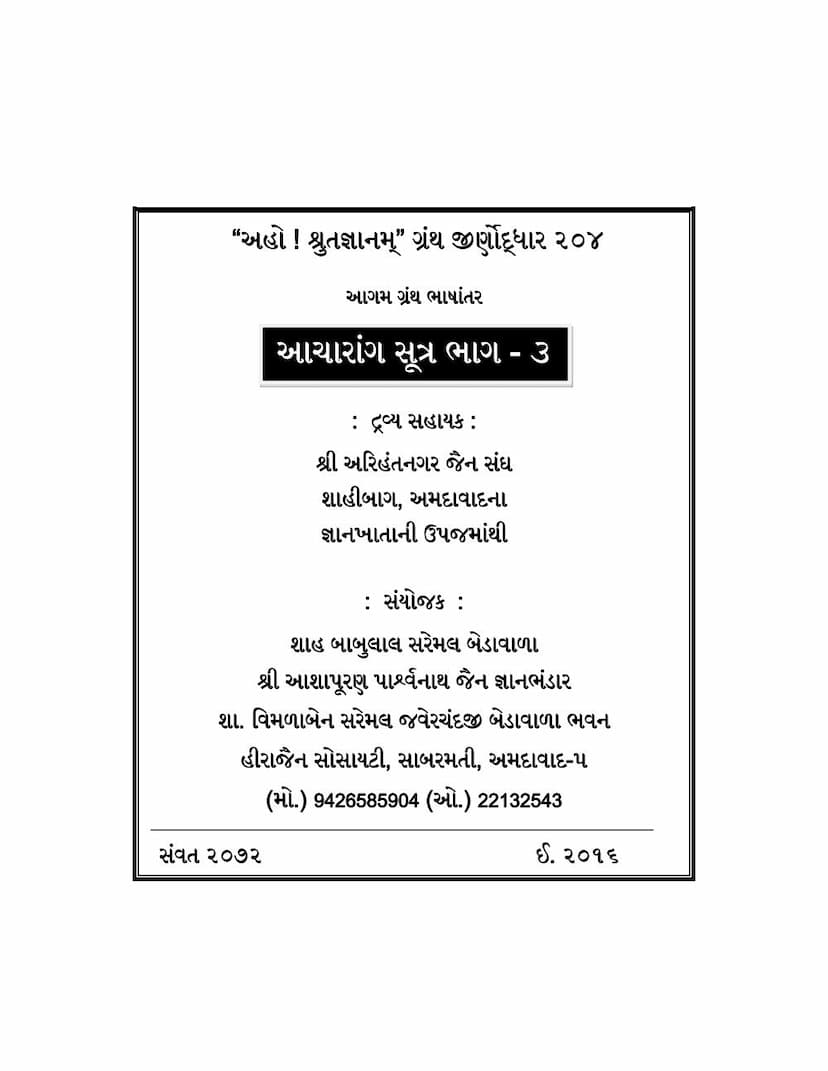Acharanga Sutra Part 03
Added to library: September 1, 2025

Summary
Here's a summary of the provided Jain text, "Acharanga Sutra Part 03," based on the pages you've shared:
Overall Context:
The provided pages are from the "Acharanga Sutra, Part 03," translated and published by the "Shri Ashapurana Parshvanath Jain Gyanbhandar." This volume is part of a larger effort to digitize and make accessible rare and ancient Jain texts. The work appears to be a scholarly endeavor, involving meticulous translation and commentary, likely based on original manuscripts. The text itself delves into the teachings of the Acharanga Sutra, a fundamental Jain scripture.
Key Themes and Content:
Based on the page numbers and the titles of the chapters and sections mentioned (primarily within the "Prastavana" and "Vishay Suchi" sections), this part of the Acharanga Sutra focuses on:
-
The Nature of Suffering and Spiritual Liberation (Moksha): A significant portion of the text seems dedicated to explaining the pervasive nature of suffering (dukkha) in the cycle of birth and death (samsara). This includes detailing the miseries associated with different life stages, the torments of hellish beings, and even the subtle suffering experienced by celestial beings. The ultimate goal is to understand these sufferings to motivate the pursuit of liberation (moksha).
-
The Path to Liberation (Samyama and Tapa): The text elaborates on the core Jain principles of samyama (restraint, self-control, discipline) and tapa (austerities, penance). It explains how these practices are essential for shedding karma and achieving spiritual freedom. Various aspects of these practices are discussed, likely including the types of austerities and the mental state required to practice them effectively.
-
The Importance of Right Faith, Knowledge, and Conduct (Samyakdarshan, Samyakjnana, Samyakcharitra): The text highlights the fundamental triad of Jainism, emphasizing that mere external practices are insufficient without the correct internal disposition. It likely discusses how right faith in the teachings of the Jinas, right knowledge of reality, and right conduct are interconnected and lead to liberation. The concept of Samyakdarshan (Right Faith) seems to be a significant focus in the later pages (Chapter 4 onwards).
-
The Role of the Ascetic (Muni/Sadhu): The text details the conduct, vows, and lifestyle of an ideal Jain ascetic. This includes discussions on their detachment from worldly possessions, their equanimity in the face of hardship (like heat and cold), their rigorous adherence to ethical principles, and their mindful conduct in all activities.
-
Analysis of Karma: There are extensive discussions related to karma, its bondage, its different types (like Mohaniya, Gyanavarniya, Vedaniya), its stages of manifestation (Udaya, Sattva), and ultimately, the process of its eradication (Nirjara). The text seems to break down the complex science of karma into understandable principles.
-
Philosophical and Ethical Debates (Naya and Vada): The text appears to engage with various philosophical viewpoints and potentially refutes or clarifies non-Jain doctrines. The mention of "Naya" (standpoints of logic) suggests a nuanced approach to understanding reality. The refutation of different sects and their beliefs is implied in the context of establishing the superiority of Jain teachings.
-
The Nature of the Soul and Reality: The text likely delves into the nature of the soul (Jiva) and its relationship with non-soul (Ajiva) substances, a fundamental concept in Jainism. The goal is to understand the soul's true, liberated nature, free from karmic impurities.
-
The Significance of the Teacher (Guru/Acharya): The importance of a spiritual guide in the path of liberation is likely underscored. The text might explain how the guru imparts the correct understanding of the scriptures and guides the disciple.
Specific Chapter/Section Mentions:
While the pages are numbered sequentially, the content flows through discussions on various topics. Some of the more prominent themes mentioned or implied by section titles include:
- Sheetoshniya Adhyayan (Chapter 3 on Heat and Cold): This chapter likely deals with the ascetic's equanimity in facing extremes of temperature and other physical hardships (Parishaha).
- Samyaktva Adhyayan (Chapter 4 on Right Faith): This chapter appears to be a significant part of this volume, explaining the essence and importance of Samyaktva.
- Lokasara Adhyayan (Chapter 5 on the Essence of the World/Path): This chapter seems to focus on understanding the nature of the world and the path to detachment and liberation.
- The fifth and sixth chapters (Lokasara, Chapter 5): These later chapters continue the discussion on the path, the nature of ascetics, and the philosophical underpinnings of Jainism.
In essence, "Acharanga Sutra Part 03" as presented here is a deep dive into the practical and philosophical aspects of Jain asceticism, emphasizing the systematic shedding of karma through restraint, austerity, right faith, knowledge, and conduct, all aimed at achieving the ultimate goal of liberation.